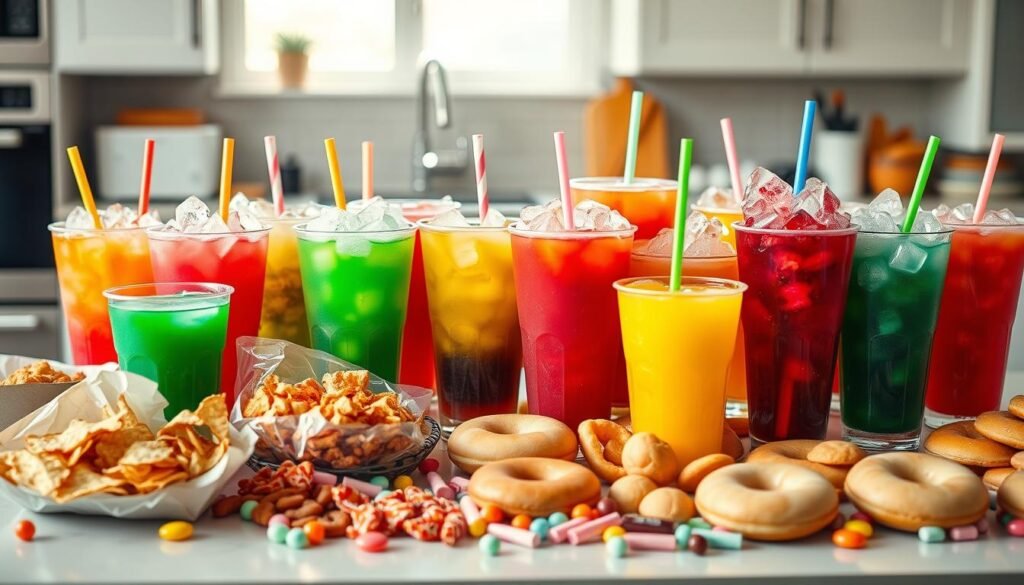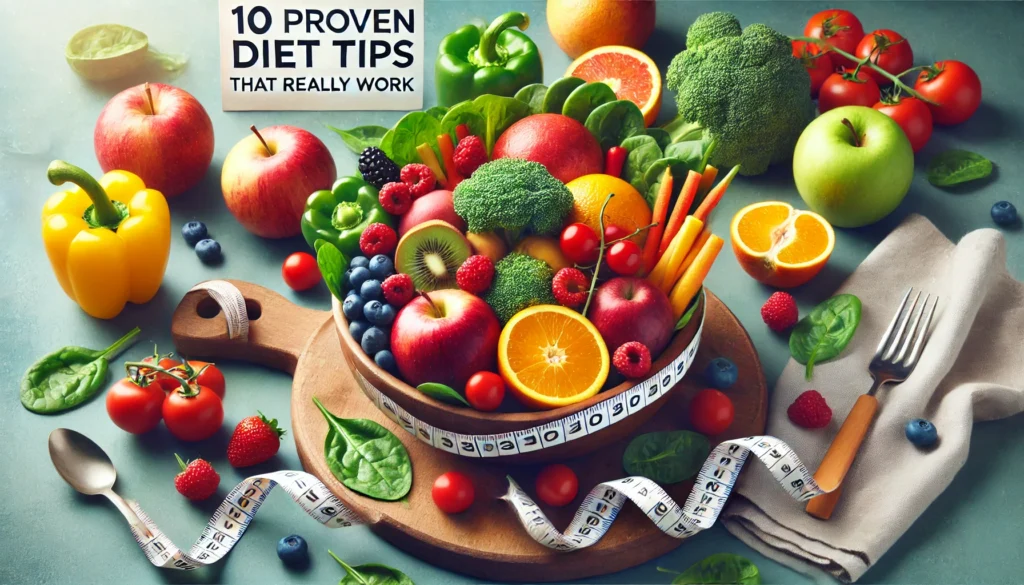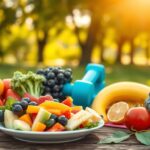Did you know that just 150 minutes of moderate-intensity exercise per week can help with weight loss? This fact from the American Heart Association (AHA) shows the importance of a balanced approach. To lose weight effectively, you need to eat right and stay active.
Eating a variety of colorful, nutritious foods is essential. Cut down on trans fats and saturated fats. Instead, eat lots of fruits, veggies, whole grains, and lean proteins. Keeping a food and weight diary helps track your progress. Aim for 150 minutes of moderate exercise each week.
Drinking less sugary drinks and alcohol can also help a lot. These drinks add empty calories without any nutritional value. Mindful eating, portion control, meal planning, and getting support are all key for lasting success.
Key Takeaways
- Engage in 150 minutes of moderate-intensity exercise weekly for successful weight loss.
- Eliminate trans fats and minimize saturated fats, focusing on a nutrient-dense diet.
- Avoid liquid calories from sugary drinks and alcohol to reduce “empty calorie” intake.
- Practice mindful eating and portion control to support a healthy relationship with food.
- Plan meals in advance and seek social support for a sustainable weight loss journey.
Understanding the Basics of Sustainable Weight Loss
Successful weight loss isn’t about quick fixes or fad diets. It’s about making lasting lifestyle changes. The key is a calorie deficit, which means eating fewer calories than you burn. This helps your body use fat for energy, leading to slow and steady weight loss.
The Science Behind Calorie Deficit
To lose weight, you need to eat fewer calories than your body uses. This forces your body to use fat for energy, causing weight loss. Aiming for a 500-1,000 calorie deficit daily is safe and can lead to 1-2 pounds of weight loss each week.
Role of Metabolism in Weight Management
Your metabolism is key in managing your weight. It’s how your body turns food into energy. Your age, gender, and muscle mass can change how fast you burn calories. Knowing your metabolic rate helps you create a plan that boosts your metabolism and aids in long-term weight loss.
Setting Realistic Weight Loss Goals
When starting your weight loss journey, set realistic goals that fit your lifestyle. Losing 10 or 15 pounds in a week or two is not safe or realistic. Aim for 1-2 pounds of weight loss per week instead. Focus on making gradual, lasting changes to your diet and exercise, not quick fixes.
Understanding calorie deficit, the role of metabolism, and setting realistic goals helps you create a successful, long-term sustainable weight loss plan. It’s tailored to your individual needs.
Creating a Nutrient-Dense Meal Plan
To lose weight sustainably, focus on a meal plan rich in nutrients. Fill your plate with nutrient-dense foods like fresh fruits, veggies, lean proteins, whole grains, and healthy fats. These foods are low in calories but packed with vitamins, minerals, and fiber. They keep you full and satisfied.
Try to eat 25-30 grams of fiber every day. Fiber is key for healthy digestion, blood sugar control, and feeling full. Avoid processed foods, added sugars, and unhealthy fats. They’re high in calories but low in nutrients, making it tough to stick to your healthy eating habits and weight loss goals.
Planning your meals ahead can be a big help. Spend some time each week planning your meals and snacks. This ensures you have a balanced and nutritious plan. It also makes mealtime easier and keeps you on track with nutrient-dense foods.
Think about getting help from a registered dietitian nutritionist (RDN). They can create a meal plan tailored to your needs and support your weight loss. With their help, you can make a sustainable, nutrient-rich eating plan for long-term success.
“Eating a diet rich in nutrient-dense foods is the foundation for healthy weight loss and overall well-being.” – Registered Dietitian Nutritionist
Essential Diet Tips for Weight Loss That Transform Your Body
For lasting weight loss, focus on smart food choices and meal timing. Building healthy eating habits is key. These tips will help you achieve a fitter, healthier body.
Smart Food Choices for Optimal Results
Choose whole, minimally processed foods for their nutrients and fiber. Lean proteins like chicken, fish, or plant-based options keep you full. Add lots of fruits and veggies to your meals for fewer calories and more vitamins.
Try fresh fruits for dessert to curb sweet cravings without extra sugar or calories.
Timing Your Meals Effectively
Eat a big breakfast and a small dinner to boost your metabolism. This supports fat loss. Also, eat every 3-4 hours to keep your energy steady and avoid overeating.
Building Healthy Eating Habits
Practice mindful eating by chewing slowly and focusing on your food. This helps you understand when you’re full, leading to better portion control. Try different meal times, like intermittent fasting, to find what works best for you.
By following these diet tips, you can change your body and lose weight for good. Remember, lasting change takes time and effort.
| Tip | Benefit |
|---|---|
| Opt for whole, minimally processed foods | Rich in nutrients and fiber, promoting feelings of fullness and satiety |
| Prioritize a larger breakfast and smaller dinner | Capitalizes on your body’s natural circadian rhythms to boost metabolism and support fat-burning |
| Practice mindful eating | Helps you better recognize hunger and fullness cues, leading to improved portion control and healthier habits |
Mastering Portion Control and Serving Sizes
Controlling your portions is key to losing weight. It helps you keep your calorie intake in check. Learning to gauge the right serving sizes is essential.
Using smaller plates and bowls can help. Studies show it can cut down your food intake by up to 22%. Knowing the right sizes, like using your palm for protein, can also guide you.
Don’t eat straight from packages. Measure your food on a plate instead. Reading labels helps you understand serving sizes and track calories.
Mindful eating is another strategy. It involves eating slowly and listening to your body’s hunger signals. This way, you avoid overeating.
Mastering portion control is vital for losing weight. By being mindful of your eating, you can make a big difference in your weight loss journey.
The Power of Mindful Eating Practices
Using a mindful eating approach can greatly help in your weight loss journey. It means being fully present and focused on your meals. You pay attention to how the food tastes and feels, not to distractions or emotions.
This way, you can tell when you’re really hungry and when you’re eating because of feelings. It helps you develop better eating habits that last.
Recognizing Hunger vs. Emotional Eating
Mindful eating helps you know the difference between hunger and eating because of feelings. Hunger is when your body needs food. Eating because of feelings is a way to deal with stress or boredom.
It teaches you to listen to your body’s hunger and fullness signals. This way, you make better choices about when and why you eat.
Techniques for Slower, Conscious Eating
Mindful eating changes how you see food. Try not eating with your hands, chewing slowly, and enjoying each bite. Don’t watch TV or use your phone while eating.
By eating slowly and focusing on your food, you eat less and feel better about eating. It’s a healthier way to eat.
Mindful eating takes time and patience to get good at. Be gentle with yourself as you learn. Celebrate every small success.
By using mindful eating, you can reach your weight loss goals. You’ll also have a healthier and more enjoyable relationship with food.
Eliminating Empty Calories and Sugary Drinks
Getting rid of empty calories from sugary drinks and processed foods is key to losing weight. These calories offer little to no nutrition and can mess up your calorie deficit plans.
Begin by ditching liquid calories from sodas, sweetened coffees, and alcohol. Switch to water, unsweetened tea, or black coffee. Also, cut down on fruit juices because they’re full of natural sugars. Choose whole fruits instead. Always check nutrition labels to spot hidden sugars in packaged foods.
- Swap out a 12-ounce beer (153 calories) for a slice of apple pie (277 calories) to reduce calorie intake.
- Choose a slice of cheese pizza over a meat and cheese pizza to save on calories.
- Opt for 3 cups of air-popped popcorn instead of oil-popped popcorn to cut calories.
Removing empty calories from sugary drinks and processed foods can greatly lower your calorie intake. This helps with weight loss. Try drinking water before meals to feel fuller and eat less.
| Beverage | Calories | Sugar (grams) |
|---|---|---|
| 7.5 oz can of A&W Root Beer | 160 | 27 |
| 20 oz bottle of Coca-Cola | 240 | 65 |
Being careful about what you drink can help you avoid a lot of empty calories. This supports your calorie deficit goals.

Strategic Meal Planning and Preparation
Effective meal planning and preparation are key for lasting weight loss. By planning and prepping meals ahead, you can eat a balanced diet. This diet supports your health and helps manage your weight.
Weekly Meal Prep Guidelines
Begin by planning your meals for the week. Think about your schedule, favorite recipes, and what ingredients are fresh. Cook meals in bulk and portion them out for easy meals all week. This saves time and helps you avoid unhealthy choices.
Smart Grocery Shopping Tips
- Create a detailed grocery list based on your meal plan to avoid impulse purchases.
- Shop the perimeter of the store, where you’ll find fresh, whole foods like fruits, vegetables, lean proteins, and whole grains.
- Read nutrition labels and compare products to make informed, healthy choices.
- Stock up on versatile, nutrient-dense staples like canned beans, whole-grain pasta, and frozen vegetables.
Efficient meal planning and preparation save time and money. They also help you develop healthier eating habits. By being proactive with your meals, you’ll be closer to reaching your weight loss goals.
“Meal prepping is a game-changer for weight loss. It takes the guesswork out of healthy eating and helps you stay on track with your nutrition goals.”
Incorporating Protein and Fiber-Rich Foods
For sustainable weight loss, focus on foods that are full of nutrients. These foods keep you feeling full and happy. Protein and fiber are key nutrients to include in your diet.
Protein helps keep your muscles strong and boosts your metabolism. Aim for 75 grams of protein daily, with 25 grams at each meal. Good sources include lean meats, fish, eggs, dairy, and plant-based options like legumes and tofu.
Fiber-rich foods, like fruits, veggies, whole grains, and legumes, make you feel full and help digestion. Adults should aim for 25-30 grams of fiber daily. Start slowly to avoid digestive issues.
Plan meals with protein, complex carbs, and healthy fats for a balanced diet. This keeps you energized and on track to your weight loss goals.
| Nutrient-Dense Foods | Protein (g) | Fiber (g) |
|---|---|---|
| 1 cup cooked lentils | 18 | 16 |
| 1 medium pear (with skin) | – | 5.5 |
| 1 cup plain nonfat Greek yogurt | 23 | 0 |
| 3 oz grilled salmon | 17 | 0 |
| 1 medium apple (with skin) | – | 4.4 |
By focusing on protein-rich foods and fiber-rich foods, you’ll make a meal plan that supports your weight loss and health.

Leveraging Water Intake for Weight Management
Drinking enough water is key to managing your weight. It helps control your metabolism, appetite, and physical performance. Adding more water to your day can boost your weight loss efforts.
Hydration Strategies for Weight Loss
Drinking water before meals can make you feel full, helping you eat less. Aim for 8-10 glasses a day, adjusting for your activity level and environment. Check your urine color to see if you’re drinking enough; light yellow or clear means you’re good.
Switching to water or unsweetened drinks from sugary ones can cut calories. Drinking cold water also makes your body work harder to warm it up, burning more calories.
Best Times to Drink Water
- Drink water first thing in the morning to kickstart your metabolism.
- Consume water 30 minutes before meals to help you feel fuller and eat less.
- Sip water between meals to stay hydrated and curb hunger throughout the day.
- Carry a reusable water bottle with you to encourage regular hydration.
- Incorporate water-rich foods like cucumbers, watermelon, and berries into your diet.
Make water a priority and time it right to help with weight management. Staying hydrated is a simple way to improve your health and wellness.
| Water Intake Recommendations | Moderate Activity Levels | High Activity Levels |
|---|---|---|
| Water Intake (oz per pound of body weight) | 0.5 oz | 0.6-1 oz |
| Daily Water Intake (for a 150 lb person) | 75 oz (approx. 9 cups) | 90-150 oz (approx. 11-19 cups) |
“Staying properly hydrated is essential for maintaining a healthy weight and achieving your fitness goals. Drinking enough water can make a significant difference in your energy levels, metabolic function, and overall well-being.”
Building Healthy Snacking Habits
Healthy snacking can change your weight loss game. Pick snacks that are full of protein, fiber, and healthy fats. This keeps you full and gives you energy all day. Try apple slices with almond butter, Greek yogurt with berries, or veggie sticks with hummus.
It’s key to have healthy snacks ready to go. Pre-portioning them helps with portion control and calorie tracking. View snacks as mini-meals to fill diet gaps and aid weight loss.
Avoid snacking without thinking, like when watching TV or working. Pay attention to when you’re hungry and enjoy your snacks fully. Adding these habits to your life leads to better weight management.





I’m still learning from you, while I’m trying to reach my goals. I absolutely love reading all that is posted on your blog.Keep the information coming. I loved it!